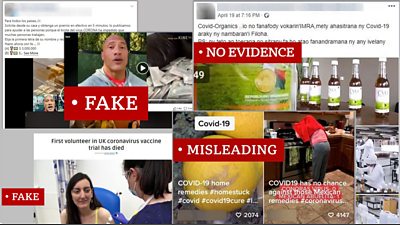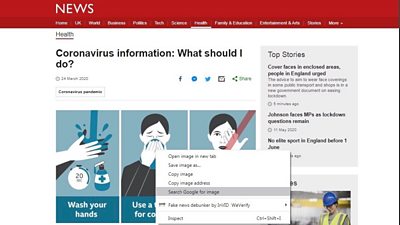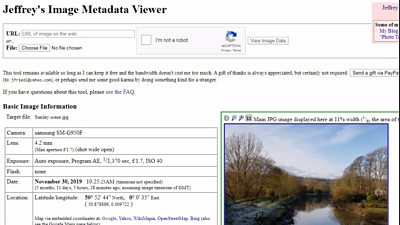
Firstly, maintain a healthy scepticism. Ask yourself, "Is this too good to be true?"
Then look for evidence to help you make a decision one way of the other as to whether something is what someone says it is. You won’t always be 100% sure but here are five ways we can look for clues. We can check:
- Provenance: is it authentic; are you looking at the original?
- Source: who created it?
- Date: when?
- Location: where?
- Motivation/intention: why?
Is it authentic?
If you see a Tweet with a suspicious looking claim, look for clues as to the authenticity of the Twitter account: When was it set up? Is the account verified? Any information in the bio? How many followers? Are the Tweets consistent in style, language and content? Any strange typos? Does the person interact with other users?
None of these clues is enough on their own but you can start to build a picture of the activity on that account that can help you decide whether it is authentic or not.
You can also use sites like and to interrogate further. These tools will give you more information about the account.
If the content you are querying was uploaded to a YouTube channel, you can look at the channel description:
- Is there one?
- Has other content been uploaded to the channel and is it consistent?
- Who subscribes to the channel?
- Does the channel link to their other social media accounts?
If you see no information beyond a name and no other content has been uploaded then this could be grounds for suspicion. If you are sent a photo claiming to be of a recent event you can easily check whether the photo is old or of some other event than that claimed.
If you use chrome as your browser, then right-click on the image you see on a website, and choose ‘search Google for image’ or you can upload the image from your computer at and search that way.

If you find the same photo has been used before, then you will know it is not of current events. A common type of disinformation is when someone uses an old photo out of context to imply something about current events that isn’t true.
You could also try which does the same job but gives you additional filters, so you could filter the results by oldest first. There is also which may well give you additional results. Using different reverse image search engines in combination may give you more information to go on.
If you have a video then you can use a Chrome extension such as which can generate key frames and run the reverse image search for you.
Source: who created it?
We need to find out more information about the source of the material, who uploaded it? Do some digging. Use the power of Google to search out names and contact information. Cross-reference information on social media accounts. Talk to experts. Use online directories, where available, or paid-for tools such as
If you can speak to the source, ask them lots of questions. You can glean additional information that you can double check to reassure yourself they are genuine. If they have sent you a photo, ask to see others they took at the same time.
Date: when did this happen?
When you take a photo with a digital device it captures additional information known as exif data. This includes the time and date that the image was taken as well as the location and the device it was taken on. If you have the original photo you can upload it to which will show you this information. You need the original photo to do this so ask the person to email it to you. If they send it via a messaging app such as WhatsApp, the exif data gets stripped out and this won’t work.

This tool will also give you the location coordinates and allow you to check the location in Google maps, is it where they said it was?
If a video has been uploaded to YouTube you can check the upload information with the . This will show you the date of that upload but will also generate key frames that you can reverse image search to see if there is an older version that has been uploaded previously.
Checking the weather can also give you clues about dates. Does the weather information in the photo match the actual weather at the time of the claimed event? You can enter the date and location and check the weather with to test this.
Location: where did this happen?
This is where your powers of observation come in. What can you see in the photo or video? Does this match the location? Look for signs, clothing, logos, weather, and language. In videos, listen for sounds and accents. All of these elements give you clues you can check, often with a simple Google search. You can practice your skills with this
Motivation: who said that and why?
Think about the person who is sharing information and why they might be doing that. What’s in it for them? Might there be a political motivation? Or is the person known for strong beliefs in conspiracy theories that would lead them to say this? Do they have something they are promoting? Maybe the person sharing the false information made a mistake, not realising it wasn’t true, but thought they were being helpful. Or maybe they have an agenda and want to intentionally deceive. Thinking about the motivation of the person can be another clue as to whether it is true or not.
By now you will hopefully have amassed enough information to help you decide whether something is genuine or not. You still may not be 100% sure but you should have a body of evidence. If the claims are circulating widely, other fact-checkers might be looking into them too.
There are lots of great fact-checking organisations around the world such as:
- Open source investigators, Bellingcat.
You can check out research (login required) or sign up to the on WhatsApp which can update you with recently debunked claims about coronavirus.
If you’d like to learn more then you can check out the which should give you everything you need to know to successfully navigate your way to the truth. There is also a fantastic selection of advice for journalists and training materials at .